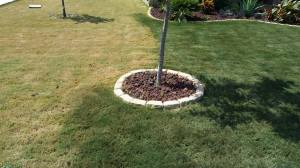Now that most of our lawns are brown, many folks are pining the loss of their lush, green landscapes and looking for a potential quick fix. There’s lot of talk about installing fake grass or painting or dying the lawn green, but what are the ramifications?
While painting or dyeing the lawn is cheaper than installing fake grass, it is not without its concerns. It is touted as eco-friendly by paint and dye companies, but most of the colorings contain heavy metals as part of their formulations.
A study done at Clemson University showed that these products disrupts the lawn’s ability to cool itself through transpiration, causing elevated temperature. Painted lawns had an average temperate of 110 degrees. Heavy concentrations of zinc and copper also were found. The products need to be reapplied after a few months; your lawn will continue to grow and at some point the coloring will be mowed off.
There have been no in-depth studies as to how soil health is affected, but in the Clemson study, turf quality was reduced with long-term use.
There are several brands of artificial turf to choose from. Many look surprising real; some even have a grasslike feel. Most products are made by attaching plastic blades to a urethane backing, then using crumb rubber — made from recycled tires — as infill to create that cushioned feel underfoot.
Crumb rubber has the potential to release a complex variety of chemicals into the air. It can also harbor bacterial growth, which can be transmitted to folks who have frequent contact. There are even concerns around increased cancer rates among athletes with extensive exposure to artificial turf.
Heat also is a concern. According to a study by Brigham Young University when the outdoor temperate is 90 to 100 degrees, synthetic grass can reach a temperature up to 200 degrees.
Then there’s the smell. Years ago I put in small amount of fake lawn for my dog. In just a year, even in part shade and with weekly cleaning, it reeked of urine and had to be removed. If you’re considering creating such a spot, I recommend laying a thick carpet of compost in the area.
Eventually artificial turf will break down and need to be removed. It will then sit in the landfill, releasing harmful gasses into the environment.
Turfgrasses are an alternative. They are relatively inexpensive, provide excellent control of soil erosion, floods and dusts while returning oxygen to the air, sequestering carbon and providing heat dissipation and temperature moderation. They also reduce noise and glare, and provide a highly desirable surface for outdoor sports and activities.
There are many water-wise, low maintenance options for having that iconic lawn. Native grasses, once established, use very little water. There are a variety of sod options that use 50 percent less water than traditional turf lawns.
The issue isn’t really as much about the lawn itself, but how we maintain it. A lawn really only needs water twice a week, and only enough to moisten the top 12 inches. To avoid runoff, aerate and compost your lawn once or twice a year, use a mulching mover and leave the grass clippings on.
By reducing the size of your lawn and creating planting areas of native, water-wise plants that support our local habitat, you really can have a gorgeous landscape and save water, too.
Rebecca Jepsen is a Santa Clara County Master Gardener.


 Being an avid gardener, born and raised in Indiana, I feel incredible blessed to live in sunny California & be able to grow my own food all year-round! I write a monthly garden column for the San Jose Mercury News & am constantly striving for tips & ideas on how to live a little more gently in regards to ourselves, our planet & each other – basically sustainability we can live with! As a
Being an avid gardener, born and raised in Indiana, I feel incredible blessed to live in sunny California & be able to grow my own food all year-round! I write a monthly garden column for the San Jose Mercury News & am constantly striving for tips & ideas on how to live a little more gently in regards to ourselves, our planet & each other – basically sustainability we can live with! As a 



